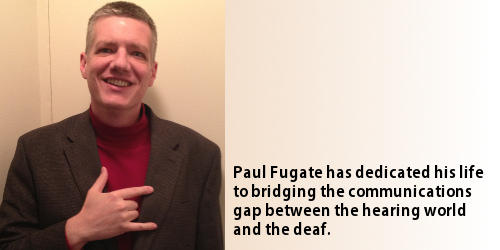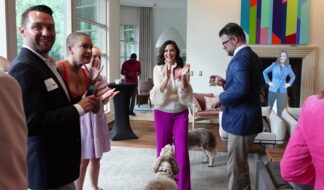
When Paul Fugate was 13 years old, he worked in an apple orchard in Romeo with a man who could not hear. Later on when it was time to select a college and start on a career path, he remembered the man from the apple orchard and decided to spend his life bridging the communications gap between the hearing world and the deaf. He also discovered the importance of teaching others how to sign and interpret, and that the skill was in high demand in the Michigan job market.
Related Stories:
The Audacity to Exist
Signs of Love: Recession-Proof Job And A Website To Learn From
DEAF C.A.N HIV/AIDS Program Offers Wide Range Of Services
"It's sort of recession-proof," Fugate said. "There will always be deaf people and a need for ASL (American Sign Language)." Fugate began his career as an interpreter in a school district and moved up to teaching ASL. With the state requiring two years of a foreign language, many districts are now offering ASL as an option. He found himself teaching at the high school and college level, as well as working for a video relay service that aids in telephone communication for the deaf.
Through all those experiences he learned more about the needs of the deaf community. He realized that about 90 percent of all deaf people are born to hearing parents, but that only about 25 percent of those take the time to learn ASL.
That means that most parents of deaf children are unable to communicate effectively with their child. "Deaf children get left out," Fugate said. "I've seen so many who don't even know what their parents do for a living. They only know what time their parent gets home from work, but they know nothing about what they do. If you imagine a family sitting around having dinner and dad talking about his day at work, the deaf child doesn't know what is being said. They don't have that bond of getting to know their parents."
Fugate said most family members say they don't have time to learn ASL. Some get by with gestures, or try to force lip reading and speaking. They simply muddle through at home, hoping the child learns all they need to at school. "You can imagine how some may not have close ties with their families, because they can't even have conversations." This is the fundamental barrier to growth and education. Most deaf people can only read at a 4th grade level, largely because of this lack of family communication.
The dedicated teacher and interpreter wanted to do something to change that. So he paired up with a fellow interpreter, Mercy Gonzles, to come up with an effective education system for parents and others wanting to learn ASL outside a traditional class. After four years of development and thousands of dollars in personal investment, they created a web-based learning program called ASLDeafined. With monthly packages under $25 (less if you buy longer-term), ASLDeafined is great for deaf and hearing people looking to learn or sharpen their skills.
The program includes a personalized progress chart, themed lessons, retention activities and quizzes, fingerspelling, a 10,000+ video dictionary, a customizable vocabulary bank, a deaf grammar section and lessons on deaf culture, ASL grammar and ASL syntax.
"It's a great way to learn for people who are busy," Fugate said. He explained that the average user keeps using the program for about a year, and there are about 10,000 subscribers at any given time. In addition to deaf people and families, schools can use the website to offer more help to students.
In addition to just learning the language, users of ASLDeafined get acquainted with the deaf culture, learning syntax and history that is important. "Because family ties are not always strong, deaf people really connect with each other. When deaf people get together they can sit for hours signing because they have so much to say that they don't always get to. They share a common bond and the ties are strong."
The site even shares history. In one entry, for example, deaf people are credited with the creation of the "huddle" in football. "The quarterback of the Gallaudet University football team in 1892, Paul D. Hubbard, invented the huddle. Hubbard realized that using sign language to communicate with the teams plays could be understood by the opposing team, especially because they often played other deaf teams. He created the huddle as a way to communicate to his teammates while shielding their plans from the other team and the spectators," ASLDeafined says.
Increasing the number of people with ASL skills is something that Fugate and Gonzales are passionate about. "At the public school I teach at, I have students come in and tell me they work at McDonalds or Subway or wherever and they had a deaf person come in. They're so excited that they were able to sign with the person and take their order with dignity. You never know when you will meet someone and be able to help them. Deaf people are like everyone else. They eat out, they go to hotels, they buy gas, and they go to the grocery store. You can run into a deaf person anywhere," Fugate said. He also noted that businesses are required to provide translator services for deaf customers, a fact that puts the profession in high demand.
Any amount of time spent learning ASL can be useful. Fugate said that even 1-2 hours a week in lessons can make a big difference in the lives of deaf people. ASLDeafined has a free trial option where people can explore some of the lessons and vocabulary before signing up for the program. To learn more go to http://www.asldeafined.com.










